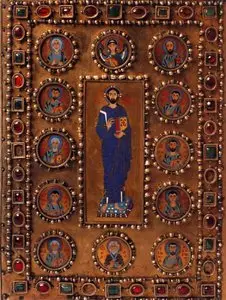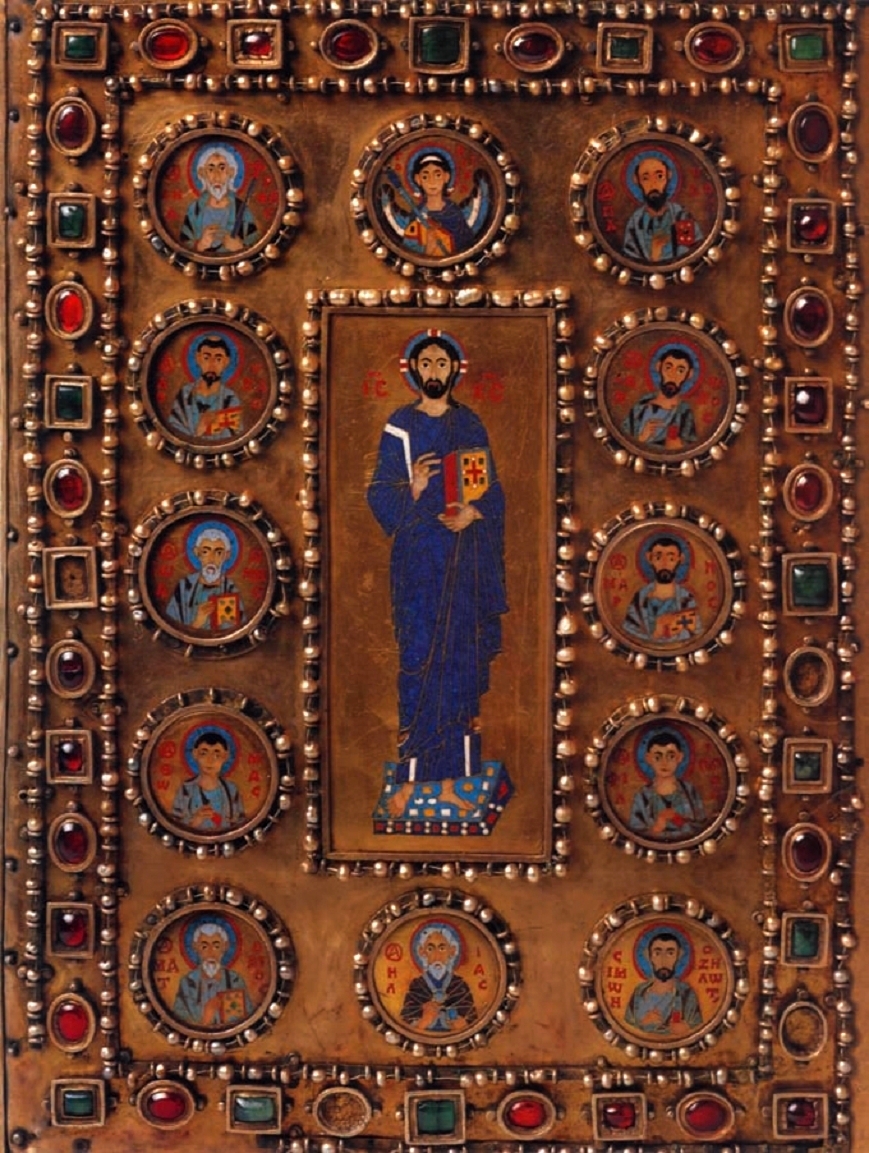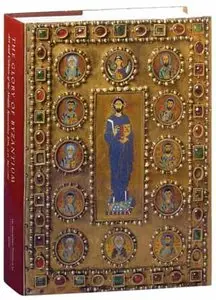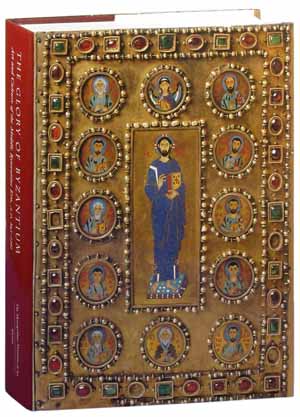Evans, Helen C., & William D. Wixom, "The Glory of Byzantium: Art and Culture of the Middle Byzantine Era, A.D. 843–1261"
Metropolitan Museum of Art/H.N.Abrams | 1997 | ISBN: 0870997777/0810965070 | English | PDF | 596 pages | 85.71 Mb
Metropolitan Museum of Art/H.N.Abrams | 1997 | ISBN: 0870997777/0810965070 | English | PDF | 596 pages | 85.71 Mb
In A.D. 843, following the resolution of the Iconoclastic controversy, which had raged throughout the Byzantine Empire for more than a century, the use of icons—images—was triumphantly reinstated in the Orthodox Church. This momentous event inspired much of the art of the following four centuries, which comprises the second great era of Byzantine culture and provides the starting point of this volume. The Glory of Byzantium, and the exhibition that it accompanies, concludes with the demise of the empire's role as a world power, evidenced by the Latin occupation of Constantinople from 1204 to 1261.
Conceived as the sequel to the landmark exhibition "Age of Spirituality," which was held at The Metropolitan Museum of Art in 1976 and focused on the first centuries of Byzantium, "The Glory of Byzantium" explores four interrelated themes: the religious and secular culture of the Second Golden Age of the Byzantine Empire; the empire's interaction with its Christian neighbors and rivals; its relations with the Islamic East; and its contact with the Latin West. Bringing together the contributions of fifty-nine scholars and art historians, most of them working in the United States, the text explores the complex currents of Byzantine civilization in its myriad facets. More than 350 works of art assembled for the exhibition from 119 institutions in 24 countries are discussed and illustrated in the catalogue. Together they present a significant selection of the most beautiful and meaningful works that survive from the empire's Second Golden Age and from the countries that constituted its extended sphere of influence. Liturgical objects—including icons, mosaics, chalices, patens, and reliquaries—and secular objects—silks, ivories, ceramics, jewelry, and manuscripts—reflect the dynamic nature of the art of this era both within and outside the empire.
The first half of the volume treats the historical context, the religious sphere, and the secular courtly realm of the empire; the second half focuses on the interactions between Byzantium and other medieval cultures, including Islam and the Latin West. The 17 essays are accompanied by detailed discussions of the works of art and by full-color photographs, as well as by views of architectural sites and comparative illustrations. Many of these illustrations were made specifically for this volume by Bruce White, photographer, on site in Greece, Turkey, Egypt, Italy, Bulgaria, Hungary, Georgia, Ukraine, and the Russian Federation.
Statement by the Ecumenical Patriarch of the Orthodox Christian Church
Sponsors' Statements
Director's Foreword
Preface
Acknowledgments
Lenders to the Exhibition
Contributors to the Catalogue
Map: Byzantium and Its Neighbors, A.D. 843–1261
Byzantine Society and Civilization
Speros P. Vryonis, Jr.
Religious Organization and Church Architecture
Thomas F. Mathews
Catalogue numbers 1–40
Manuscripts
Jeffrey C. Anderson
Catalogue numbers 41–64
Popular Imagery
Annemarie Weyl Carr
Catalogue numbers 65–136
Images of the Court
Henry Maguire
Secular Architecture
Robert G. Ousterhout
Catalogue numbers 137–147
Luxury Objects
Ioli Kalavrezou
Catalogue numbers 148–178
Ceramic Arts of Everyday Life
Eunice Dauterman Maguire
Catalogue numbers 179–192
Christian Neighbors
Helen C. Evans
Kievan Rus'
Olenka Z. Pevny
Catalogue numbers 193–219
The Bulgarians
Joseph D. Alchermes
Catalogue numbers 220–229
The Georgians
S. Peter Cowe
Catalogue numbers 230–237
The Armenians
Helen C. Evans
Catalogue numbers 238–243
Christians in the Islamic East
Thelma K. Thomas
Catalogue numbers 244–257
Crusader Art
Jaroslav Folda
Catalogue numbers 258–268
Byzantium and the Islamic East
Priscilla Soucek
Catalogue numbers 269–289
Byzantine Art and the Latin West
William D. Wixom
Catalogue numbers 290–344
Notes to the Essays
Bibliography
Glossary
Index
Sponsors' Statements
Director's Foreword
Preface
Acknowledgments
Lenders to the Exhibition
Contributors to the Catalogue
Map: Byzantium and Its Neighbors, A.D. 843–1261
Byzantine Society and Civilization
Speros P. Vryonis, Jr.
Religious Organization and Church Architecture
Thomas F. Mathews
Catalogue numbers 1–40
Manuscripts
Jeffrey C. Anderson
Catalogue numbers 41–64
Popular Imagery
Annemarie Weyl Carr
Catalogue numbers 65–136
Images of the Court
Henry Maguire
Secular Architecture
Robert G. Ousterhout
Catalogue numbers 137–147
Luxury Objects
Ioli Kalavrezou
Catalogue numbers 148–178
Ceramic Arts of Everyday Life
Eunice Dauterman Maguire
Catalogue numbers 179–192
Christian Neighbors
Helen C. Evans
Kievan Rus'
Olenka Z. Pevny
Catalogue numbers 193–219
The Bulgarians
Joseph D. Alchermes
Catalogue numbers 220–229
The Georgians
S. Peter Cowe
Catalogue numbers 230–237
The Armenians
Helen C. Evans
Catalogue numbers 238–243
Christians in the Islamic East
Thelma K. Thomas
Catalogue numbers 244–257
Crusader Art
Jaroslav Folda
Catalogue numbers 258–268
Byzantium and the Islamic East
Priscilla Soucek
Catalogue numbers 269–289
Byzantine Art and the Latin West
William D. Wixom
Catalogue numbers 290–344
Notes to the Essays
Bibliography
Glossary
Index
Helen C. Evans is Associate Curator of Early Christian and Byzantine Art in the Department of Medieval Art at The Metropolitan Museum of Art. In 1995–96, she co-curated "Textiles of Late Antiquity" at the Metropolitan Museum, and in 1994, "Treasures in Heaven: Armenian Manuscripts in American Collections" at The Pierpont Morgan Library, New York, and at the Walters Art Gallery, Baltimore.
William D. Wixom is Michel David-Weill Chairman of the Department of Medieval Art and The Cloisters, The Metropolitan Museum of Art. The major exhibitions he has curated include "Gothic and Renaissance Art in Nuremberg" at the Metropolitan Museum in 1986; "The Treasury of San Marco" in 1988 at the same institution; and "Treasures from Medieval France" in 1966–67 at The Cleveland Museum of Art.
William D. Wixom is Michel David-Weill Chairman of the Department of Medieval Art and The Cloisters, The Metropolitan Museum of Art. The major exhibitions he has curated include "Gothic and Renaissance Art in Nuremberg" at the Metropolitan Museum in 1986; "The Treasury of San Marco" in 1988 at the same institution; and "Treasures from Medieval France" in 1966–67 at The Cleveland Museum of Art.
Choice Reviews Online
"This catalog of the stupendous exhibition of Byzantine art that closed in July 1997 is by far the most lavish example of the genre yet produced. Weighing nearly seven pounds and recording more than 400 objects (clusters of similar pieces are sometimes grouped in a single entry), it automatically becomes for scholars a standard reference work … Almost every piece is superbly reproduced in color, often for the first time."
From Library Journal
The catalog of a major exhibition on Byzantium that just closed at New York's Metropolitan Museum of Art, this exquisitely produced volume contains essays by leading scholars that describe the objects exhibited and place them within a specific area of the Byzantine empire. Speros Vryonis Jr. leads off the collection with an essay on "Byzantine Society and Civilization." Other notable sections include Toli Kalavezou's "Luxury Objects," Jerry Folda's "Crusader Art," and S. Peter Crowe's "The Georgians." The editors' discussion of the culture of the period is quite thorough and offers new insights. The quality of the reproductions is very good, and both the extensive bibliography and the glossary are highly useful. One only wishes that the footnotes appeared at the bottom of the page rather than at the back of the volume. This work should be included in larger academic and public libraries.?Martin Chasin, Adult Inst., Bridgeport, Ct.
Copyright 1997 Reed Business Information, Inc.
Midwest Book Review
The Glory Of Byzantium is a stunning, 604 page coffee-table artbook based on the exhibition of the art at the Metropolitan Museum of Art of the Middle Byzantine period beginning with the restoration of the use of icons by the Orthodox Church in 843 and ends with the occupation of Constantinople by the Crusader forces from the West and 1204 to 1261. The Glory Of Byzantium explores four interrelated themes: the religious and secular culture of the Second Golden Age of the Byzantine Empire; the empire's interaction with its Christian neighbors and rivals; its relations with the Islamic East; and its contact with the Latin West. Bringing together the contributions of 59 scholars and art historians, the text explores the complex currents of Byzantine civilization. More than 350 works of art assembled from 119 institutions in 24 countries are discussed and illustrated in the catalogue, presenting a significant selection of works that survive from the empire and from the countries that constituted its extended sphere of influence. Liturgical objects (including icons, mosaics, chalices, ceramics, jewelry, and manuscripts) reflect the dynamic nature of the art of this era both within and outside of the empire. The first half of the volume treats the historical context, the religious sphere, and the secular courtly realm of the empire; the second half focuses on the interactions between Byzantium and other medieval cultures, including Islam and the Latin West. The seventeen essays are accompanied by views of architectural sites and comparative illustrations. The Glory Of Byzantium is a highly recommended for academic or community libraries, and would be especially appropriate as a Memorial Fund acquisition selection.
"This catalog of the stupendous exhibition of Byzantine art that closed in July 1997 is by far the most lavish example of the genre yet produced. Weighing nearly seven pounds and recording more than 400 objects (clusters of similar pieces are sometimes grouped in a single entry), it automatically becomes for scholars a standard reference work … Almost every piece is superbly reproduced in color, often for the first time."
From Library Journal
The catalog of a major exhibition on Byzantium that just closed at New York's Metropolitan Museum of Art, this exquisitely produced volume contains essays by leading scholars that describe the objects exhibited and place them within a specific area of the Byzantine empire. Speros Vryonis Jr. leads off the collection with an essay on "Byzantine Society and Civilization." Other notable sections include Toli Kalavezou's "Luxury Objects," Jerry Folda's "Crusader Art," and S. Peter Crowe's "The Georgians." The editors' discussion of the culture of the period is quite thorough and offers new insights. The quality of the reproductions is very good, and both the extensive bibliography and the glossary are highly useful. One only wishes that the footnotes appeared at the bottom of the page rather than at the back of the volume. This work should be included in larger academic and public libraries.?Martin Chasin, Adult Inst., Bridgeport, Ct.
Copyright 1997 Reed Business Information, Inc.
Midwest Book Review
The Glory Of Byzantium is a stunning, 604 page coffee-table artbook based on the exhibition of the art at the Metropolitan Museum of Art of the Middle Byzantine period beginning with the restoration of the use of icons by the Orthodox Church in 843 and ends with the occupation of Constantinople by the Crusader forces from the West and 1204 to 1261. The Glory Of Byzantium explores four interrelated themes: the religious and secular culture of the Second Golden Age of the Byzantine Empire; the empire's interaction with its Christian neighbors and rivals; its relations with the Islamic East; and its contact with the Latin West. Bringing together the contributions of 59 scholars and art historians, the text explores the complex currents of Byzantine civilization. More than 350 works of art assembled from 119 institutions in 24 countries are discussed and illustrated in the catalogue, presenting a significant selection of works that survive from the empire and from the countries that constituted its extended sphere of influence. Liturgical objects (including icons, mosaics, chalices, ceramics, jewelry, and manuscripts) reflect the dynamic nature of the art of this era both within and outside of the empire. The first half of the volume treats the historical context, the religious sphere, and the secular courtly realm of the empire; the second half focuses on the interactions between Byzantium and other medieval cultures, including Islam and the Latin West. The seventeen essays are accompanied by views of architectural sites and comparative illustrations. The Glory Of Byzantium is a highly recommended for academic or community libraries, and would be especially appropriate as a Memorial Fund acquisition selection.







